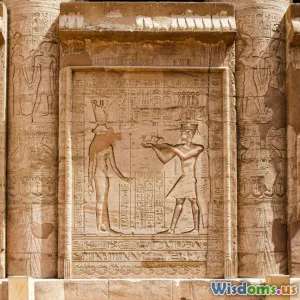
Mysteries of Ancient Scripts
6 min read Explore the enigmatic world of ancient scripts, their significance, and the mysteries surrounding their meanings and origins. (0 Reviews)
Mysteries of Ancient Scripts
Throughout history, written language has played a pivotal role in the development of civilizations. Ancient scripts not only provide insight into the cultures that created them but also pose intriguing mysteries that continue to baffle scholars today. From undeciphered languages to lost texts, the enigma of ancient scripts invites us to explore the past in ways we have yet to fully understand.
The Importance of Ancient Scripts
Ancient scripts serve as the primary sources of information for understanding past civilizations. They document everything from daily life to grand historical events. However, many of these scripts remain only partially understood, with some still completely undeciphered.
For example, the Cuneiform script, developed by the Sumerians around 3200 BCE, is one of the earliest forms of writing. It evolved over time and was used for various languages across the ancient Near East. The decipherment of Cuneiform in the 19th century opened doors to understanding Sumerian, Babylonian, and Assyrian cultures, but many tablets remain untranslated, containing secrets about their societies that are still locked away.
The Enigma of Undeciphered Scripts
While many ancient scripts have been deciphered, several remain a mystery, sparking curiosity among researchers and amateur enthusiasts alike. One of the most famous undeciphered scripts is the Indus Valley script, found on seals and pottery from the ancient civilization of the Indus River Valley, dating back to 2600-1900 BCE. Despite numerous attempts to decode it, the script's meaning and structure remain elusive, leaving a significant gap in our understanding of one of the world's earliest urban cultures.
Another notable example is the Linear A script, used by the Minoans on Crete from approximately 1800 to 1450 BCE. While Linear B, a related script, has been deciphered and is known to represent an early form of Greek, Linear A has yet to reveal its secrets, leading to ongoing debates about the language it represents and the culture that used it.
The Impact of Language Evolution
The evolution of language itself can complicate the understanding of ancient scripts. As languages change over time, so too do the symbols and meanings associated with them. The Egyptian hieroglyphs, for example, offer a rich tapestry of language that evolved over thousands of years. While many hieroglyphs have been deciphered, the nuances of their meanings and the contexts in which they were used still hold mysteries for modern scholars.
Furthermore, the cultural context surrounding these scripts can also influence their interpretation. The Mayan script, which was used to record the history and mythology of the Maya civilization, was only partially understood until the late 20th century. Even now, many glyphs remain undeciphered, and the full narrative of Maya history continues to unfold as researchers make new discoveries.
Archaeological Discoveries and Their Relevance
Recent archaeological finds often reignite interest in ancient scripts and can provide crucial context for deciphering them. The discovery of new artifacts can lead to the reevaluation of existing texts or even contribute to the understanding of entire civilizations. For instance, the Rosetta Stone, found in 1799, was instrumental in deciphering Egyptian hieroglyphs because it contained the same text in three scripts: Greek, Demotic, and hieroglyphic.
Similarly, the unearthing of new inscriptions in the ancient city of Pompeii has provided fresh insights into the Latin language and the social dynamics of Roman life. Each discovery adds a layer of depth to our understanding of ancient cultures and the scripts they created.
Conclusion: The Quest for Understanding
The mysteries surrounding ancient scripts remind us of the complexities of human history and the ongoing quest for knowledge. As we continue to uncover new artifacts and develop better analytical tools, the hope is that we will unlock more of the secrets held within these ancient writings. The stories they tell are not just about the past; they shape our understanding of humanity’s journey through time.
In exploring these ancient scripts, we not only seek to understand the words of our predecessors but also to connect with the thoughts, cultures, and experiences that have shaped our world today. The mysteries of ancient scripts are a testament to the enduring power of language and the human desire to communicate and record our existence.
Rate the Post
User Reviews
Popular Posts





















